This was published 3 years ago
‘I was swept away’: Spielberg fulfils childhood dream with reimagined West Side Story
The man who gave us Raiders of the Lost Ark and Jurassic Park is also a Broadway nerd. Who knew?
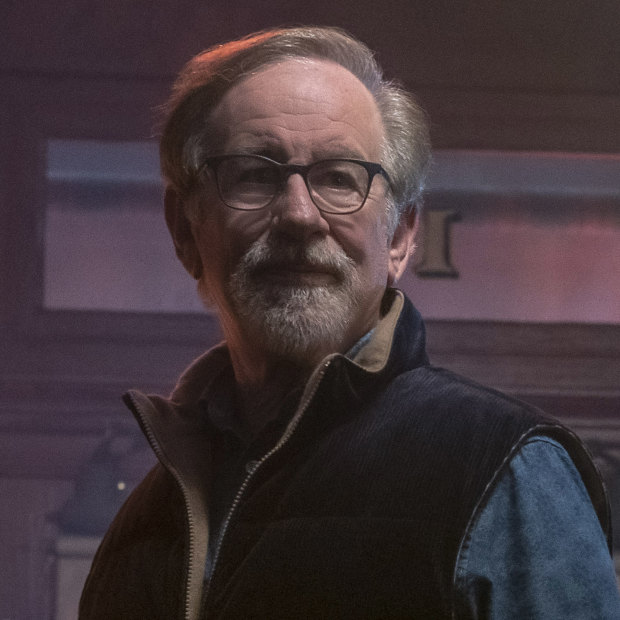
Director Steven Spielberg and actress Rita Moreno on the set of West Side Story.Credit: 20th Century Studios
You think you know Steven Spielberg, and then he goes and remakes West Side Story. This is, after all, the filmmaker whose body of work is defined by Jaws, Raiders of the Lost Ark, E.T. and Jurassic Park. When you see a Spielberg film you expect to buckle up for the ride; you don’t expect everyone to burst into song and dance along the way.
But it turns out Steven Spielberg isn’t just a man of action, he’s a Broadway kid who, at the age of 10, sat in his parents’ Phoenix, Arizona, living room transfixed by the sound of the cast album of West Side Story. As it spun at 33-and-one-third revolutions per minute on the family’s Victrola record player, “I was swept away by this musical narrative,” Spielberg says.
“My imagination was my only experience mounting it on stage, or even in a cinematic proscenium because I could only imagine what it looked like as I was listening to the singing,” Spielberg says. “And I could only imagine what the dancing was like when I was listening to the portions of the score that inspire and uplift the dance. So, the first stage on which I experienced West Side Story was my imagination.”

“I could only imagine what it looked like as I was listening to the singing,” says Steven Spielberg of his childhood encounter with West Side Story.Credit: Disney
Few former 10-year-old kids have the opportunity to bring their imagination to life quite like Spielberg does, so it is perhaps unsurprising that some 64 years later, his own West Side Story – starring Ansel Elgort and Rachel Zegler as star-crossed lovers Tony and Maria – is taking its bow on the cinema screen. The only question is, what took him so long?
The film is a lavish love letter to the Broadway original, shot by cinematographer Janusz Kaminski, arranged musically by composer David Newman and with dance choreography by the New York City Ballet’s Justin Peck. It also features legendary actress Rita Moreno, who starred in the earlier, much-loved 1961 film adaptation.
Unlike many later productions he saw, the West Side Story of Spielberg’s imagination was grittier. “It was different when I first saw it on stage, it was not as tough as my imagination had made it out to be, it was not as ‘street’ as my imagination told me it should look like,” Spielberg says.
“In a way, those first years I spent listening to West Side Story on a record kind of informed not only my approach, but the approach [screenwriter] Tony Kushner took in adapting the original Broadway show to this new screen version. I think we’ve made it tougher, and it’s much more overt. It’s much more focused on the characters, and the characters talk much more like people talk today, even though we still set our story in 1957.”
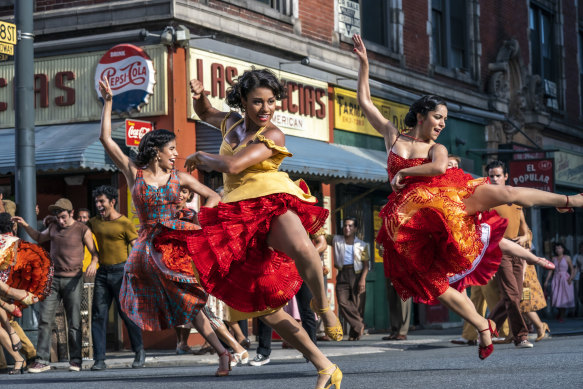
Ilda Mason as Luz, Ariana DeBose as Anita and Ana Isabelle as Rosalia in West Side Story.Credit: Niko Tavernise/20th Century Studios
Unlike many Broadway musicals, West Side Story is one of a handful – along with Beauty and the Beast, Into the Woods and Seussical – which are staged frequently as high school productions. The effect is that for many people they first encounter the story of the clash between the Sharks and the Jets at the most impressionable time of their lives.
“West Side Story is about kids, and it’s about kids surviving in an adult world of tremendous racial division and also the intolerance of not caring to understand another culture or another point of view,” Spielberg says. “And that resonates with young people, despite the energy of the dance of the prologue, the energy of the Jets song and so on.
“I think young people seeing West Side Story for the first time go right to the love story, and then go right to the love story between two young people on different sides of the racial tracks,” Spielberg adds. “And I think that especially when this started becoming available to high schools back in the 1960s, that was a real eye-opener.”
Spielberg came to this project having seen almost every production of the show, from the 1961 film adaptation – directed by Robert Wise and Jerome Robbins – several Broadway productions and, most recently, Arthur Laurents’ 2009 revival, which brought Spanish lyrics and dialogue into the English libretto for the first time.
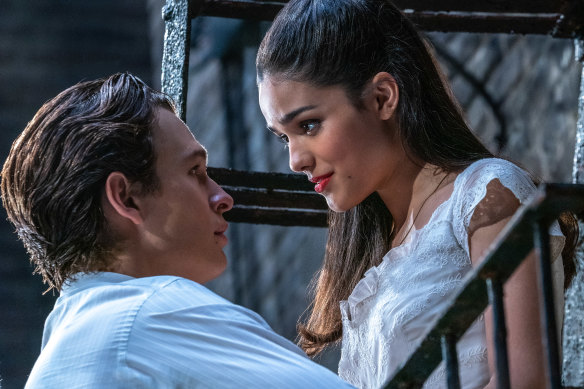
Ansel Elgort as Tony and Rachel Zegler as Maria in West Side Story.Credit: 20th Century Studios.
“One of the chief values of art for all humankind is that art explores empathy, and that’s what I think our story does more than anything else, even empathy between people who have absolutely no connection with each other, through all the divisiveness and racial barriers that they throw up against each other, and that society has thrown to them to throw up against each other,” Spielberg says.
“I think this is an exploration of empathy and also a kind of morality tale because this is a tragedy, as is the stage play,” Spielberg adds. “Why can’t we find the thing we have in common? That would’ve made a world of difference between the Sharks and the Jets had these kids been smart enough and patient enough with each other, which they’re not, and nor are many of the kids today.”
Spielberg signed on to direct the film in 2018 and spent a year looking for the right actors to play Maria, Tony, Anita and Bernardo. For two-and-a-half months in Harlem, and locations around Brooklyn and New Jersey, the pieces of the film were slowly assembled. But before all of that, Spielberg picked up the phone and called Walter Mirisch, who had produced the 1961 film, which starred Richard Beymer as Tony and Natalie Wood as Maria.
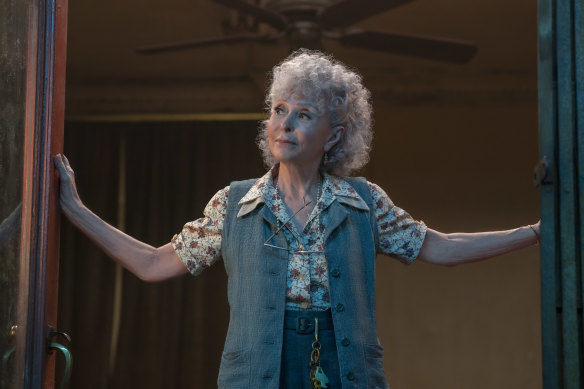
Rita Moreno, who played Anita in the 1961 version, plays Valentina in Spielberg’s West Side Story.Credit: 20th Century Studios
“I took him to lunch, not the first time I’ve taken Walter to lunch,” Spielberg says, laughing. “And Walter helped me. He’d brought in behind-the-scenes photographs that nobody had ever seen of the making of [the 1961] West Side Story. He gave me anecdotes about the production. He told me all about working with Rita. And he was very supportive.”
For Spielberg, the presence of Moreno – an executive producer on the 2021 film, and in the role of Valentina, a rewrite of the original character drug store owner Doc – was important. “I needed someone who had lived the neorican experience,” he says. “I hired advisers from Puerto Rico who helped us be as authentic as we could as storytellers, but it wasn’t the same.
“I needed someone who could impart the wisdom every day of this production of that lived experience as a member of the cast and the crew,” Spielberg says. “And Rita is someone with a gravitas that frankly, only Rita possesses. She simply lives and breathes the story. And it’s not just the story of the west side. It’s her story as a human being.
“Rita was a force to be reckoned with. And she was a gift to our cast because our cast looked at her as the only link between their involvement in this story and the original motion picture production of West Side Story. It assured everyone that we were all on the same page, doing righteous work, to tell a great story that deserves to be told again.”
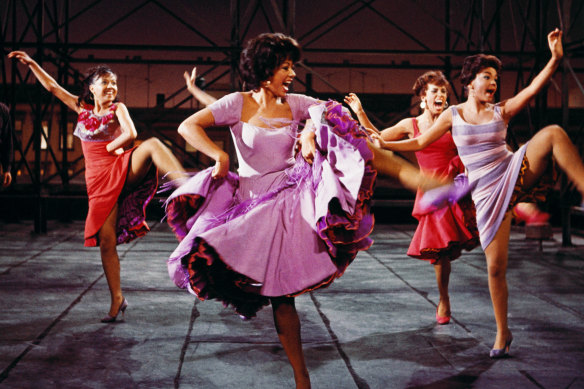
Rita Moreno in the orginal West Side Story.Credit: Getty Images
As the Jet gang member Tony, Spielberg cast Ansel Elgort. As Maria, the sister of Sharks leader Bernardo, he cast Rachel Zegler. And as Anita, Bernardo’s girlfriend, and the role which won Moreno an Oscar, he cast Ariana DeBose. DeBose says that from a very young age she “fell in love with [Spielberg’s] abilities as a storyteller; he spoke to your soul, both as a creative person and just as a human.”
“But I never thought I’d get this part ... not in a million years. I had no business being Anita. And then, suddenly it became very real. And I remember walking into a room and I just looked at him, and I was like, if I am going to do this, I am going to choose not to be wildly starstruck.”
Working with Moreno on the remake, DeBose says, was like meeting “a legend in her time, and you can feel that when you’re with her. But she’s also a wonderful woman. She shared whatever I wanted to know. Whatever I asked, she was always willing to answer. She gave me great insight, but she was also quick to remind me that I didn’t need her insight necessarily.”
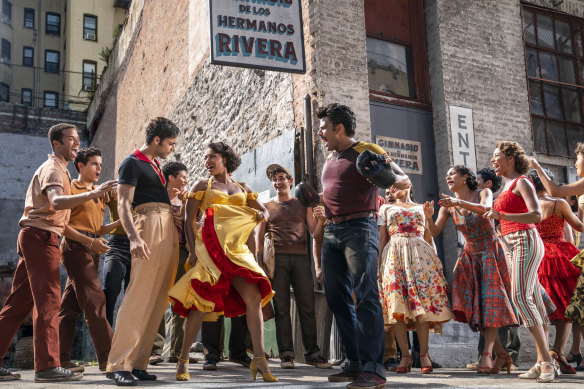
Ariana DeBose as Anita and David Alvarez as Bernardo in West Side Story.Credit: 20th Century Studios
Back in 1947, when Jerome Robbins approached Leonard Bernstein and Arthur Laurents about collaborating on a contemporary musical adaptation of Romeo and Juliet, Laurents’ story spoke to his own lived experience and the reality of the world at the time. Despite its age, however, West Side Story has a lot to say about life in 2021.
“This story speaks more to what the originators of West Side Story were intending to talk about today than it did in 1957,” Spielberg says. “We’re in a very dangerously reactive period of time and a very ignorant period of time, where people on both sides ... are simply not willing to talk to each other,” he says.
America has, Spielberg says, “never been as divided in my lifetime as it is right now. And I feel the story of the Sharks and the Jets is happening all over this country, as we speak.”
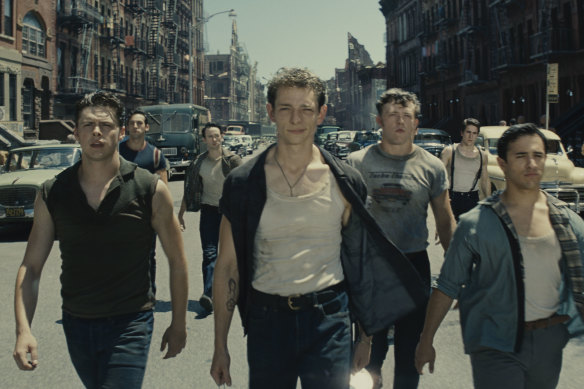
Rival gangs go into battle in West Side Story.Credit: 20th Century Studios.
But whether art is naturally political is more complex. “I think West Side Story, certainly for the first 60 per cent of the story, whether on stage or on screen, is a celebration of life and love and fidelity,” Spielberg says. “And then of course, traditionally like Romeo and Juliet, it disintegrates into such division that borders on tragedy and then becomes a very, very sad story. That’s just the nature of the beast. That’s what it’s always been.”
The film also puts to celluloid what many will say is a definitive version of West Side Story. It is suffused with the “exuberant kineticism of its musical set pieces,” according to Vulture. And it is “rougher, grittier, more lived-in ... but also more unabashedly classical, more radiantly stylised, than just about anything a major American studio has released in years,” says the Los Angeles Times.
In that sense the permanence of celluloid presents us with something unexpected for a musical that has been evolving since the original Broadway production opened in New York on September 26, 1957.
“Because you can only find a film in one place, there is a kind of firmament when you make a movie,” says Spielberg. “And of course you can remake a movie, I’ve remade several films. But there are certain classics that had they been popular as stage plays, there’d be an argument for taking licence and finding another way to tell that story. But if it’s just a movie, and it’s found its way into the classic Hollywood firmament, those are more untouchable.”
Spielberg is cautious about the idea that his version might become the enduring West Side Story. “I see West Side Story as something that is constantly performed all over the world and is constantly in transition, in wonderfully creative and imaginative ways,” he says. “And that’s what I hope we’ve done with this.”
For the next filmmaker, then, the dream better be big. When Spielberg and I last spoke, a few years ago, he told me that he “dreams for a living”. When I remind him of that, he says that while his dreams are still as big and wild today as they were when he was a kid, he has turned his gaze outwards more in recent years, to the complexities of the world.
“I’m not a cynical person, and I’ve always been recklessly optimistic, but I think that in recent years, my stories have been less from my imagination and more as a reflection of the world that I’m continuing to grow up in,” Spielberg says.
“There’s a time and place for my imagination. [But] I think everything I’ve worked on the last decade, almost everything has been a cautionary tale,” he adds. “And I just think because I’m a reflection, not just from my imagination when I’m dreaming for a living, as I once said, but it’s a reflection of my responsibility and duty as a person on this planet, just trying to make this a better place to live.”
West Side Story is in cinemas from December 26.